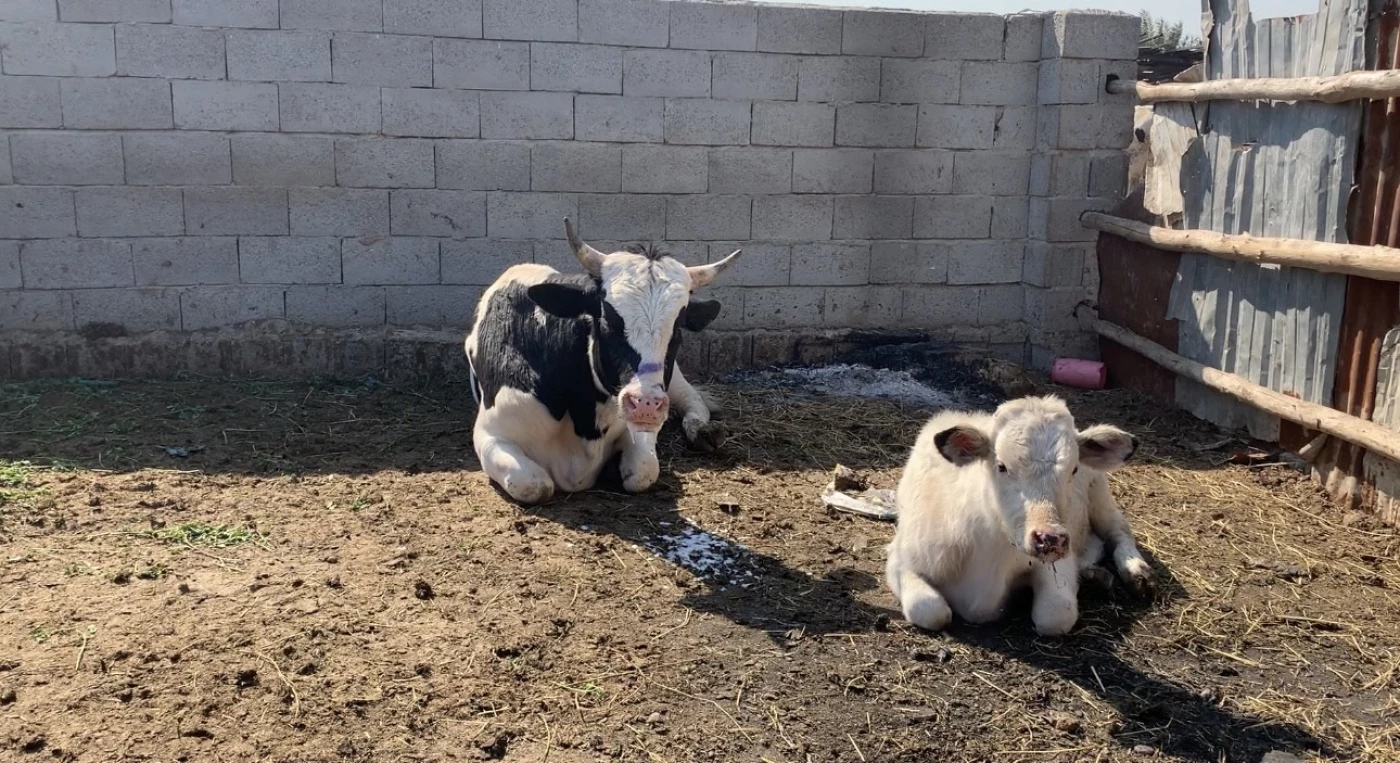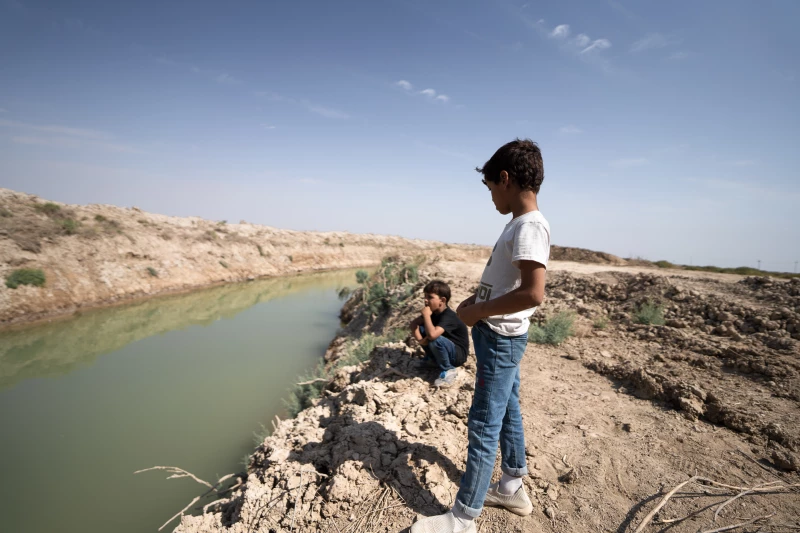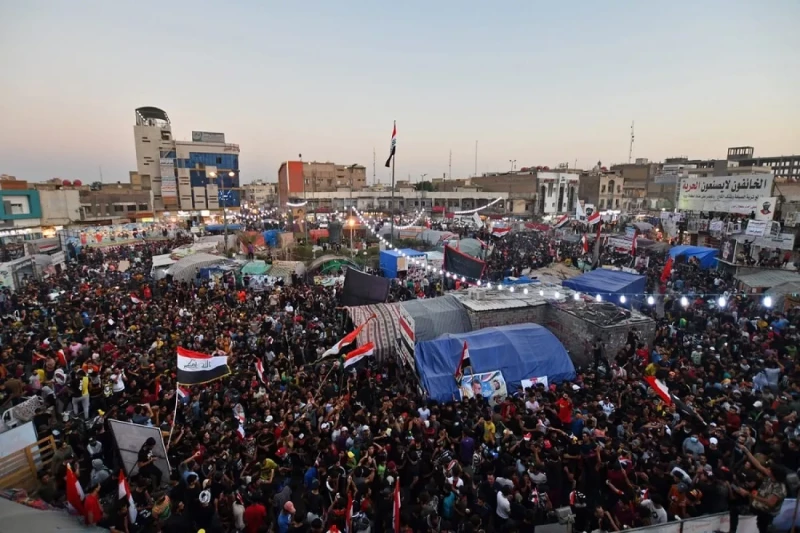BAGHDAD, Iraq - At the Fadhiliya farm in Baghdad, where Mansour al-Zubaidi used to wake up to the sounds of his buffaloes and immerse himself in the details of his day tending to the herd and milking the females, a heavy silence has now settled. There are no longer any morning bellows, no hurried footsteps crossing the farm back and forth.
“The disease came to us like a hurricane... it swept through everything, leaving us no choice but to watch a lifetime of hard work collapse before our eyes,” said Zubaidi, his voice heavy with pain.
Zubaidi, one of the breeders affected by the epidemic, told The New Region, “It started suddenly… the first buffalo stopped eating, it began staggering, its saliva was dripping, and then it collapsed. After that, infections spread like wildfire. Whether big or small, nursing or pregnant, it made no difference… Within days, the farm turned into a graveyard, and the buffaloes that did not die stopped moving, drinking, eating, and could not be milked.”
“The worst part of all this is that the disease is terrifyingly contagious. We could not protect the healthy herd, every head of cattle was infected one after the other at an unbelievable speed. We tried everything we could, but we were powerless against this deadly virus.”
Zubaidi looked at the land where his ancestors had lived, the land he inherited to continue their legacy of buffalo breeding, then exhaled bitterly, “Centuries of hard work have turned to dust.”
In the midst of this catastrophe, no official knocked on his door, no veterinary doctor contacted him, and no aid or vaccines arrived. He remained alone in his battle, along with the buffaloes that were once his sole source of livelihood, as he put it.
Foot-and-mouth disease spreading
Several regions across Iraq have witnessed the rapid spread of a deadly virus affecting livestock in recent days, particularly in the outskirts of Baghdad (Fadhiliya, Bismayah, Jurf al-Naddaf, Hayal-Wahda, Nahrawan), extending through Hilla, specifically the al-Iffar area, reaching Badoush, west of Mosul in Nineveh province, as well as Basra, which has reported cases of the disease. After five days of investigations, the foot-and-mouth disease was identified as the primary culprit.
Faleh al-Khuzai, chairman of the Parliamentary Committee on Agriculture and Marshlands, stated, “The spread of this epidemic has had severe negative effects on Iraq's livestock, prompting us to take urgent measures to curb its outbreak.”
“We have directed the relevant authorities to increase the number of mobile teams to monitor the situation on the ground and conduct thorough tests on vaccines while intensifying their distribution in the most affected provinces,” he added.
He pointed out that efforts are particularly focused on Baghdad, Hor al-Dalmaj, Dhi Qar, Amarah, and Basra, out of fear that the disease will continue to spread and impact the national livestock sector.
Khuzai also stressed the necessity of following strict preventive measures when handling deceased animals, explaining, “Burial operations will be carried out according to well-studied health protocols, including the allocation of safe burial sites, treating carcasses with disinfectants before burial, and ensuring that no contaminants reach groundwater sources or agricultural lands.”
He added that “veterinary and environmental authorities will oversee the burial process to ensure compliance with global health standards, with strict supervision over the disposal of dead animals to prevent any violations that could lead to environmental or health risks for citizens and farmers in areas near the burial sites.”
Khuzai confirmed that compensation mechanisms for affected breeders will be implemented in accordance with Executive Order No. (30) of 2024, ensuring support for livestock owners and compensating them for their losses caused by the outbreak of this epidemic.
Uninspected border crossings
Amid the spread of foot-and-mouth disease and the rising number of dead livestock, another equally serious issue emerges, the mechanisms for importing livestock into Iraq and the veterinary oversight at border crossings.
Rafiq al-Salihi, a member of the Parliamentary Committee on Agriculture and Marshlands, shed light on a direct link between the outbreak of the disease and the recent arrival of imported cattle from countries such as India, Colombia, and Brazil, without undergoing strict inspection procedures.
Veterinary teams did not detect the spread of the disease until after the imported livestock reached local farms and came into contact with Iraqi herds, allowing the virus to spread at an alarming rate. Salihi emphasized this point, stating, “This means that the imported cattle were not subjected to the necessary inspections before entering Iraq.”
As investigations into the border crossings begin, Salihi confirmed that the relevant authorities are reviewing the procedures followed at these entry points to determine the reasons behind the lack of veterinary oversight and to prevent a recurrence of this crisis in the future.
“It is essential to enforce strict monitoring of livestock imports and require authorities to conduct thorough inspections before allowing any animals into the country, to prevent the infiltration of new epidemics that threaten food security and the livestock economy,” he added.
When imports become a curse
At the heart of the crisis that has devastated buffalo breeders, while losses mount with no solutions in sight, Laith Shakir, one of the affected breeders, stands helpless before the destruction of his livelihood, painfully asking: “What is our fault?”
Shakir, filled with anger and sorrow, says, “We want to file a complaint against the entities that imported foreign buffaloes and calves and brought them into Iraq through ports without inspecting them. How can livestock be allowed into the country without ensuring they are disease-free? The result has been catastrophic… Our local buffaloes were infected, and death wiped out massive numbers in just a few days.”
The numbers are shocking. Shakir confirms, “A family that once owned a hundred buffaloes now has only a quarter of that number left. In just five days, more than five thousand buffaloes died in Fadhiliya alone, and God knows how many were lost in other provinces.”
The crisis is not just about the death of livestock, it has affected the lives of families who depend solely on buffalo breeding for their livelihood, leaving them drowning in debt.
“Each of our families is in debt by at least 20 million dinars or more. We have children and women to provide for… How can we ensure them a decent life after losing everything? Where do we go? Who do we turn to for help with this disaster that has broken our backs?” decried Shakir.
Meanwhile, Naeem Mazen, another buffalo breeder, criticized Iraq's continued reliance on livestock imports, despite the country's rich animal resources, which could sustain local demand for years.
He said that the local livestock industry is more than capable of meeting market needs. Yet, time and again, the government resorts to importing cattle without clear justification, putting domestic production at risk.
“There is no explanation for this policy other than financial and administrative corruption. Livestock is being imported purely for trade and profit, without any strict health monitoring to ensure that diseases do not spread to our local animals,” he added.
Mazen stressed that relying on local production would protect the national livestock sector, reduce the risk of epidemics, and support Iraq's economy rather than funneling money abroad. He demanded stricter monitoring of import operations and the implementation of policies that shield local breeders from recurring losses due to these reckless decisions.
Ineffective vaccine and overlooked local alternatives
Haj Hussein Jassim al-Aqeeli, a prominent figure in Fadhiliya, called for an urgent investigation, urging Prime Minister Mohammed Shia’ al-Sudani to personally intervene to address the root causes of the crisis and take swift action to contain it.
“The treatments provided to breeders are imported and ineffective, despite Iraq having specialized national facilities such as al-Kindi Company for Veterinary Vaccines and Medicines, which produces high-quality treatments under the supervision of skilled professionals,” said Aqeeli.
Aqeeli questioned why no contracts were made with local companies, especially since domestically produced treatments are very affordable, while millions of dollars are spent on importing vaccines from abroad.
He emphasized that relying on local production would provide more effective solutions to combat epidemics and strengthen the national economy, urging the relevant authorities to review import policies and support local manufacturing in the veterinary sector.
Can it be transmitted to humans?
Firas Riyadh Jamil, a professor of biotechnology and infectious diseases, clarified that “the foot-and-mouth virus does not pose a direct threat to Iraqi citizens, as it does not transfer from animals to humans,” reassuring the public that the disease remains confined to livestock.
However, Jamil noted that butchers are the most at-risk group, as direct contact with infected meat, particularly if they have open wounds, could lead to skin infections requiring medical intervention. He stressed the importance of following strict precautionary measures, including sanitizing tools, wearing gloves while handling meat, and seeking immediate medical attention if any skin infection occurs.
Jamil also advised consumers to avoid consuming unpasteurized dairy products and undercooked meat during this period to eliminate any potential health risks associated with infected animal products.
Similarly, Majid al-Kaabi, an expert in animal health, urged citizens to purchase meat only from licensed, inspected slaughterhouses or from trusted suppliers to avoid potential contamination or spoilage. He also emphasized the need to check the color of meat before purchasing, as healthy meat should be pink or light red, while dark-colored meat may indicate poor quality, requiring careful inspection before consumption.
Kaabi called for strict adherence to hygiene and food safety standards when cooking and storing meat to ensure public health and prevent any risks.
A crisis under control?
Comments by Karim al-Saray, a member of the parliament’s health committee, have raised questions about the true extent of the disease’s spread and its actual impact on livestock. While media reports highlight “alarming” numbers of infections, Saray downplays the scale of the disaster, asserting that the outbreak is not as widespread as portrayed and that, despite its deadly effect on livestock, the virus remains relatively simple in nature, comparable to influenza in humans.
According to Saray, government measures include banning the transportation of livestock between provinces as a preventive step to contain the spread. While this decision is logical from a precautionary standpoint, it raises an important question: Did these measures come too late? And was there strict oversight into imported livestock, which is suspected to have introduced the virus into the country, as some parliamentary reports suggest?
Between official statements reassuring the public and media reports sounding the alarm, the biggest question remains: Do Iraq’s veterinary and regulatory institutions have the capacity to control this crisis, or is the country facing yet another challenge in safeguarding its livestock amid weak health oversight? The coming days should provide the answer.
FAO steps in; A race against the epidemic
With growing concerns over the wider spread of foot-and-mouth disease, attention is shifting to the response of the Food and Agriculture Organization of the United Nations (FAO), which is closely monitoring developments and coordinating with the relevant government authorities. The issue extends beyond livestock health, it directly affects food security and the local economy, making international intervention an urgent necessity.
“The organization is providing all necessary technical support to the ministry by supplying data and information that contribute to assessing the current situation and minimizing the risks associated with the outbreak,” Salah al-Haj Hassan, FAO's representative in Iraq, told The New Region.
Despite the significance of international support, the biggest challenge lies in Iraq’s veterinary infrastructure. As the FAO representative noted, sending infected samples to international reference laboratories may ensure an accurate diagnosis, but it also highlights Iraq’s lack of specialized local laboratories capable of handling such cases efficiently and swiftly.
Beyond technical support, FAO is also focusing on awareness campaigns, as he emphasized, “We are implementing initiatives aimed at educating breeders about the dangers of the disease, its modes of transmission, and the necessary preventive measures to protect their livestock. The goal is to avoid reaching a stage where stricter measures, such as increased market surveillance and updates to quarantine policies, become necessary.”
While FAO’s response is an important step, it remains only one part of a broader solution, one that Iraqi authorities must lead by strengthening veterinary capabilities, improving inspection and monitoring systems, and investing in advanced local laboratories. Will this crisis push the authorities to rethink sustainable animal health policies, or will emergency solutions continue to be the only option?
Additional reporting by Amr Al Housni



 Facebook
Facebook
 LinkedIn
LinkedIn
 Telegram
Telegram
 X
X


